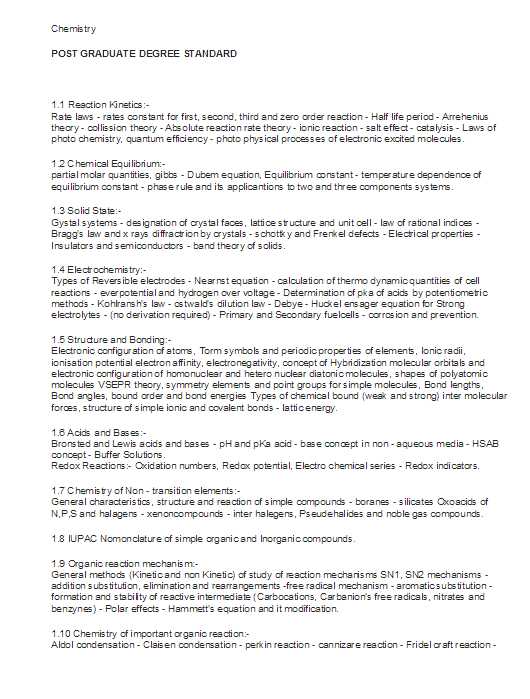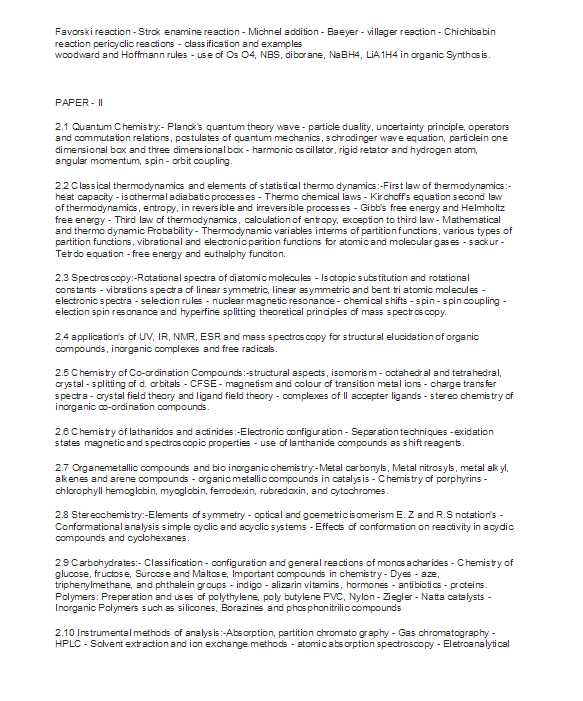| 17th June 2017 03:56 PM | |
| pawan | Re: TNPSC Chemistry Syllabus As you are looking for syllabus of Chemistry published by TNPSC, so here I am providing complete syllabus: TNPSC Chemistry Syllabus 1.1 Reaction Kinetics:- Rate laws-rates constant for first, second, third and zero order reaction-Half life period-Arrehenius theory-collission theory-Absolute reaction rate theory-ionic reaction-salt effect-catalysis-Laws of photo chemistry, quantum efficiency-photo physical processes of electronic excited molecules. 1.2 Chemical Equilibrium:- Partial molar quantities, gibbs-Dubem equation, Equilibrium constant-temperature dependence of equilibrium constant-phase rule and its applicantions to two and three components systems. 1.3 Solid State:- Gystal systems-designation of crystal faces, lattice structure and unit cell-law of rational indices-Bragg's law and x rays diffractrion by crystals-schottky and Frenkel defects-Electrical properties-Insulators and semiconductors-band theory of solids. 1.4 Electrochemistry:- Types of Reversible electrodes-Nearnst equation-calculation of thermo dynamic quantities of cell reactions-everpotential and hydrogen over voltage-Determination of pka of acids by potentiometric methods-Kohlransh's law-ostwald's dilution law-Debye-Huckel ensager equation for Strong electrolytes-(no derivation required)-Primary and Secondary fuelcells-corrosion and prevention. 1.5 Structure and Bonding:- Electronic configuration of atoms, Torm symbols and periodic properties of elements, Ionic radii, ionisation potential electron affinity, electronegativity, concept of Hybridization molecular orbitals and electronic configuration of homonuclear and hetero nuclear diatonic molecules, shapes of polyatomic molecules VSEPR theory, symmetry elements and point groups for simple molecules, Bond lengths, Bond angles, bound order and bond energies Types of chemical bound (weak and strong) inter molecular forces, structure of simple ionic and covalent bonds-lattic energy. 1.6 Acids and Bases:- Bronsted and Lewis acids and bases-pH and pKa acid-base concept in non-aqueous media-HSAB concept-Buffer Solutions. Redox Reactions:- Oxidation numbers, Redox potential, Electro chemical series-Redox indicators. 1.7 Chemistry of Non-transition elements:- General characteristics, structure and reaction of simple compounds-boranes-silicates Oxoacids of N,P,S and halagens-xenoncompounds-inter halegens, Pseudehalides and noble gas compounds. 1.8 IUPAC Nomonclature of simple organic and Inorganic compounds. 1.9 Organic reaction mechanism:- General methods (Kinetic and non Kinetic) of study of reaction mechanisms SN1, SN2 mechanisms-addition substitution, elimination and rearrangements -free radical mechanism-aromatic substitution-formation and stability of reactive intermediate (Carbocations, Carbanion's free radicals, nitrates and benzynes)-Polar effects-Hammett's equation and it modification. 1.10 Chemistry of important organic reaction:- Aldol condensation-Claisen condensation-perkin reaction-cannizare reaction-Fridel craft reaction-Favorski reaction-Strok enamine reaction-Michnel addition-Baeyer-villager reaction-Chichibabin reaction pericyclic reactions-classification and examples woodward and Hoffmann rules-use of Os O4, NBS, diborane, NaBH4, LiA1H4 in organic Synthosis. PAPER-II 2.1 Quantum Chemistry:- Planck's quantum theory wave-particle duality, uncertainty principle, operators and commutation relations, postulates of quantum mechanics, schrodinger wave equation, particlein one dimensional box and three dimensional box-harmonic oscillator, rigid retator and hydrogen atom, angular momentum, spin-orbit coupling. 2.2 Classical thermodynamics and elements of statistical thermo dynamics:-First law of thermodynamics:- heat capacity-isothermal adiabatic processes-Thermo chemical laws-Kirchoff's equation second law of thermodynamics, entropy, in reversible and irreversible processes-Gibb's free energy and Helmholtz free energy-Third law of thermodynamics, calculation of entropy, exception to third law-Mathematical and thermo dynamic Probability-Thermodynamic variables interms of partition functions, various types of partition functions, vibrational and electronic parition functions for atomic and molecular gases-sackur-Tetrdo equation-free energy and euthalphy funciton. 2.3 Spectroscopy:-Rotational spectra of diatomic molecules-Isotopic substitution and rotational constants-vibrations spectra of linear symmetric, linear asymmetric and bent tri atomic molecules-electronic spectra-selection rules-nuclear magnetic resonance-chemical shifts-spin-spin coupling-election spin resonance and hyperfine splitting theoretical principles of mass spectroscopy. 2.4 application's of UV, IR, NMR, ESR and mass spectroscopy for structural elucidation of organic compounds, inorganic complexes and free radicals. 2.5 Chemistry of Co-ordination Compounds:-structural aspects, isomorism-octahedral and tetrahedral, crystal-splitting of d. orbitals-CFSE-magnetism and colour of transition metal ions-charge transfer spectra-crystal field theory and ligand field theory-complexes of II accepter ligands-stereo chemistry of inorganic co-ordination compounds. TNPSC Chemistry Syllabus   |
| 17th June 2017 03:49 PM | |
| Unregistered | TNPSC Chemistry Syllabus My brother is looking for syllabus of Chemistry published by TNPSC. He has searched but didn |